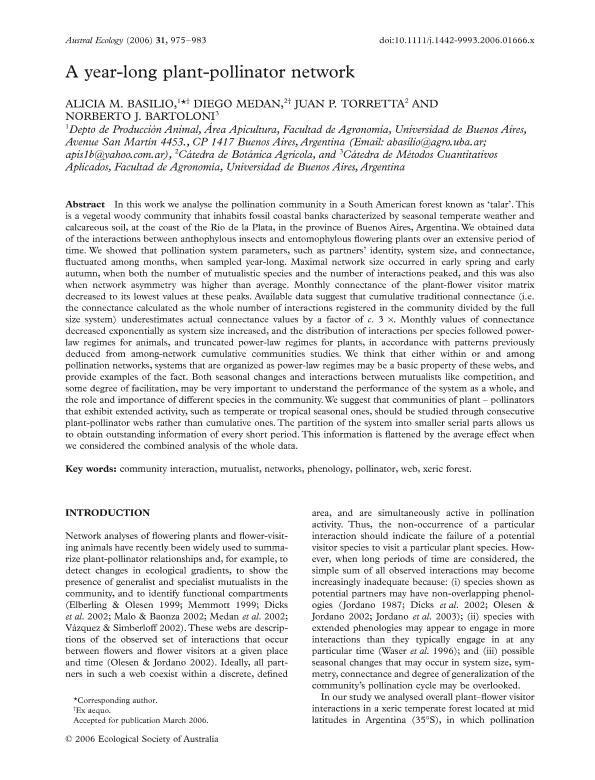Artículo
A year-long plant-pollinator network
Fecha de publicación:
12/2006
Editorial:
Wiley Blackwell Publishing, Inc
Revista:
Austral Ecology
ISSN:
1442-9985
Idioma:
Inglés
Tipo de recurso:
Artículo publicado
Clasificación temática:
Resumen
In this work we analyse the pollination community in a South American forest known as 'talar'. This is a vegetal woody community that inhabits fossil coastal banks characterized by seasonal temperate weather and calcareous soil, at the coast of the Río de la Plata, in the province of Buenos Aires, Argentina. We obtained data of the interactions between anthophylous insects and entomophylous flowering plants over an extensive period of time. We showed that pollination system parameters, such as partners' identity, system size, and connectance, fluctuated among months, when sampled year-long. Maximal network size occurred in early spring and early autumn, when both the number of mutualistic species and the number of interactions peaked, and this was also when network asymmetry was higher than average. Monthly connectance of the plant-flower visitor matrix decreased to its lowest values at these peaks. Available data suggest that cumulative traditional connectance (i.e. the connectance calculated as the whole number of interactions registered in the community divided by the full size system) underestimates actual connectance values by a factor of c. 3 ×. Monthly values of connectance decreased exponentially as system size increased, and the distribution of interactions per species followed power-law regimes for animals, and truncated power-law regimes for plants, in accordance with patterns previously deduced from among-network cumulative communities studies. We think that either within or and among pollination networks, systems that are organized as power-law regimes may be a basic property of these webs, and provide examples of the fact. Both seasonal changes and interactions between mutualists like competition, and some degree of facilitation, may be very important to understand the performance of the system as a whole, and the role and importance of different species in the community. We suggest that communities of plant - pollinators that exhibit extended activity, such as temperate or tropical seasonal ones, should be studied through consecutive plant-pollinator webs rather than cumulative ones. The partition of the system into smaller serial parts allows us to obtain outstanding information of every short period. This information is flattened by the average effect when we considered the combined analysis of the whole data.
Palabras clave:
COMMUNITY INTERACTION
,
MUTUALIST
,
NETWORKS
,
PHENOLOGY
,
POLLINATOR
,
WEB
,
XERIC FOREST
Archivos asociados
Licencia
Identificadores
Colecciones
Articulos(OCA PQUE. CENTENARIO)
Articulos de OFICINA DE COORDINACION ADMINISTRATIVA PQUE. CENTENARIO
Articulos de OFICINA DE COORDINACION ADMINISTRATIVA PQUE. CENTENARIO
Citación
Basilio, Alicia Mabel; Medan, Diego; Torretta, Juan Pablo; Bartoloni, Norberto Jose; A year-long plant-pollinator network; Wiley Blackwell Publishing, Inc; Austral Ecology; 31; 8; 12-2006; 975-983
Compartir
Altmétricas




